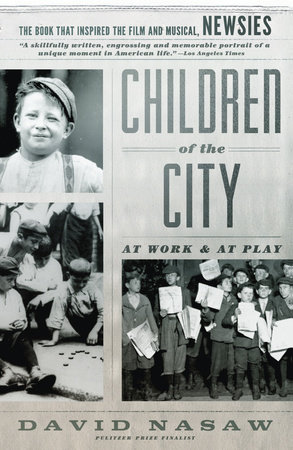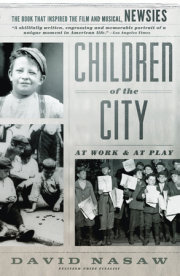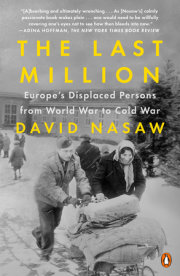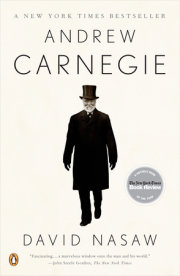1
The City They Called Home
The early twentieth-century city was among the wonders of the New World. Concentrated within it were the marvels of the age. Electric lights made night into day. Subways, streetcars, and the elevated sped commuters through the streets. Steel-girded skyscrapers and granite railroad stations expressed its solidity and its power. Lobster palaces, vaudeville palaces, movie palaces, and department store palaces of consumption re-created in the present the mythic splendors of the past.
American cities had expanded in all directions in the decades surrounding the turn of the century: up with the skyscrapers, down into the subway tunnels, outward across the bridges and tunnels to the new streetcar suburbs. The central business districts, once crowded with warehouses but not much else, had been enlarged and subdivided into financial, government, manufacturing, warehousing, shopping, and entertainment districts, each with its army of workers.1
Every morning swarms of commuters boarded their trolleys, trains, cable cars, elevateds, and subways for the ride to town. Three quarters of a million people flowed daily off the elevated into the Chicago Loop. They arrived in downtown Boston from Roxbury, West Roxbury, Dorchester, and the surrounding “streetcar suburbs.” In Cincinnati, Columbus, and Pittsburgh, they took electric streetcars from the heights into the “flats” of the central city. In Manhattan, they trooped to work across the bridges, on the ferries, and by streetcar, elevated train, and subway. Theodore Dreiser described the procession from his vantage point at the Williamsburg Bridge. “Already at six and six-thirty in the morning they have begun to trickle small streams of human beings Manhattan or cityward, and by seven and seven-fifteen these streams have become sizable affairs. By seven-thirty and eight they have changed into heavy, turbulent rivers and by eight-fifteen and eight-thirty and nine they are raging torrents, no less. They overflow all the streets and avenues and every available means of conveyance. They are pouring into all available doorways, shops, factories, office-buildings—those huge affairs towering so significantly above them. Here they stay all day long, causing those great hives and their adjacent streets to flush with a softness of color not indigenous to them, and then at night, between five and six, they are going again, pouring forth over the bridges and through the subways and across the ferries and out on the trains, until the last drop of them appears to have been exuded.”2
Those who arrived in the central business districts came to work, but they stayed to be entertained and to shop. The city’s palaces of consumption were as new, as exciting, and as spectacular as its skyscrapers and bridges. The downtown department stores, huge as factories, luxurious as the most opulent millionaire’s mansions, and jammed full of goods, were a relatively new phenomenon in the life of the city. Until the 1870s there had been no real downtown shopping streets. City folk did their shopping in neighborhood stores or from itinerant peddlers. Local shops were specialized: butcher, baker, and candlestick maker had their own establishments where they produced and sold their own goods.
The extension of the streetcar lines into the suburbs and the new concentration of white-collar workers downtown provided retailers with hundreds of thousands of customers. Old-fashioned dry goods stores were expanded into department stores and then relocated and rebuilt along the busiest streetcar and subway lines to make shopping as convenient as possible for suburban women, tourists, and downtown workers.
Visitors to the city joined the commuters and workers on the shopping streets where the department stores were located. In Manhattan, the first “Ladies’ Mile” was situated along Broadway and Fifth and Sixth Avenues between Eighth and Twenty-third Streets. There was nothing like it anywhere in the world. Wanamaker’s, a sixteen-story cast-iron giant, was at Eighth Street and Broadway, Hearn’s was on Fourteenth Street, and Siegel-Cooper’s on Sixth Avenue and Eighteenth Street with its main attraction, “The Fountain,” a circular marble terrace surrounding a mammoth marble and brass statue of “The Republic” shooting jets of water, “illuminated by myriad colored lights.” Across the street from the Big Store was B. Altman’s, a short walk away were Stern Brothers, Lord and Taylor, Arnold Constable, Best and Company, Bonwit Teller’s, W. and J. Sloane, and Macy’s.3
As the city moved northward so did the department stores. Macy’s in 1901 broke ground on its new Herald Square store—with one million square feet of floor space. Within a decade all the other downtown stores had relocated on Fifth Avenue or close by.4
In Chicago, State Street was as grand a tourist attraction as New York’s Fifth Avenue. One could wander up and down the avenue for days without running out of stores to visit and windows to peer into. There was Marshall Field’s with its forty acres of shopping and its forty-five plate glass windows; Carson, Pirie, Scott’s in its new building designed by Louis Sullivan; Fair, Rothschild’s, Siegel, Cooper and Company; the Boston Store; Mandel Brothers; and the Stevens Store—all within walking distance of one another.5
Every city had its own special stores, stores which had grown up with the downtown areas and, in the beginning, helped lure customers from the outskirts: Jordan Marsh’s and Filene’s in Boston, the original Wanamaker’s and Gimbel’s in Philadelphia, Kaufmann’s in Pittsburgh, Abraham and Straus in Brooklyn, Rich’s in Atlanta, Neiman-Marcus in Dallas, Goldwater’s in Prescott and then in Phoenix, Arizona, I. Magnin’s in San Francisco, Hudson’s in Detroit, and Lazarus in Columbus.
The department stores were more than containers of goods or huge indoor markets. They were living encyclopedias of abundance designed to overwhelm the consumer with the variety of items available for purchase. The department stores brought together under one roof an unimaginable collection of commodities, catalogued by department, arranged by floor. Furniture, rugs, and bedding were on the upper floors; ready-to-wear clothing and shoes for women and children on the middle floors; bargain goods and groceries in the basement. The street-level floors displayed clothing and accessories for men, who it was feared would not take the time to ride to the higher floors; and for the women, dozens and dozens of alluring, lower-priced items: cosmetics, notions, gloves, stationery, hosiery.6
What overwhelmed was not simply the variety of goods, but the variety and abundance of luxury goods, “from silk dresses and chocolate-covered candies to bicycles, cigarettes, and pink popcorn, which consumers had not produced themselves and which they did not need.”7
The department stores, by so artfully juxtaposing the necessary and the frivolous, redefined and intertwined needs with desires. There was so much there, at such a range of prices, it was difficult to know what to buy. Sister Carrie, recently arrived in the city from the countryside and looking for work, was directed by a policeman to “The Fair,” one of Chicago’s more massive and imposing stores. “Carrie passed along the busy aisles, much affected by the remarkable displays of trinkets, dress goods, stationery, and jewelry. Each separate counter was a showplace of dazzling interest and attraction. She could not help feeling the claim of each trinket and valuable upon her personally, and yet she did not stop. There was nothing there which she could not have used—nothing which she did not long to own. The dainty slippers and stockings, the delicately frilled skirts and petticoats, the laces, ribbons, hair-combs, purses, all touched her with individual desire.”8
One did not have to go inside to be touched by the magic of the stores. Plate-glass windows with superbly crafted displays highlighted by “the planned adoption of electrical lighting and of a new color technology, of drapery and mechanical props, of reflectors and wax mannequins, and even, occasionally of living models . . . consciously converted what had once been dull places stuffed with goods into focused show windows, ‘gorgeous’ little theatrical stage-sets, sculpted scenes, where single commodities might be presented in the best possible light.” The banks of show windows opened up the street, extending the interior opulence of the palaces onto the sidewalks and inviting the passers-by to pause and dream of the splendors inside. Window-shopping, in essence no more than a dignified form of loafing, became a new and acceptable pastime.9
If shopping brought people downtown, entertainment establishments kept them there after dark or, to be more accurate, after the sun went down. There was, in reality, no more “dark” in the theater districts. Street lighting, first by kerosene and gas, then by electric arc and incandescent lights, extended day into night. Theater marquees, billboards, and restaurants with plate glass windows revealing and highlighting the gaiety within converted dark, deserted streets into well-lit thoroughfares of fun and fantasy. Broadway, the Great White Way, illuminated for two miles between Madison and Longacre Squares, was the prototype for the all-night entertainment district, but every city had its theaters, its restaurants, its hotels, its vaudeville palaces, and motion picture shows.10
Night life, once the province of lower-class characters and men who acted as if they were, had moved out from the tenderloin and vice districts into the lights of the new and expanded “Broadways.” Every city had its cheap public dance halls, saloons, and whorehouses, but for those who wanted to be entertained without shame and guilt and in the company of respectable women, there were new and proper places to do it.11
The vaudeville theaters were the first establishments to, quite literally, clean up their acts. Once a men-only affair, with prostitutes cruising the aisles, profanity rampant, “girly shows” on stage, and the aroma of stale beer inescapable, vaudeville had, in the 1870s and 1880s, been transformed into acceptable, wholesome entertainment for the entire family. “Jeering, drinking, smoking, and soliciting were all but abolished by policing. Managers also clamped down on vulgar stage language and actions, creating a strict system of censorship that outlawed the uttered ‘hell’ and ‘damn.’ ”12 Animal acts, magicians, pantomimists, and ladies who played the “concertina, banjo, and xylophone” were brought in to replace the “blue” acts that had once been standard.13
Though vaudeville shows could be seen in every town, at country fairs, and at amusement parks, it was in the cities that the theaters attracted the largest number of customers. In New York City there were, by 1910, thirty-one different vaudeville houses. Chicago had twenty-two, Philadelphia thirty.14
Vaudeville brought the middle classes—in the thousands—downtown for the show. It was not, however, the only attraction of the entertainment districts. There were also the variety theaters and the music halls, where on any given night one could see operettas, new musical comedies like Little Johnny Jones and George Washington Junior, melodramas, or Shakespeare. Arnold Bennett, on his trip to the United States in 1912, was astounded to find “nearly twice as many first-class theaters in New York as in London.”15
Within walking distance of the theaters were restaurants to wine, dine, and be seen in. Dining out, once the preserve of society people who could afford fancy hotel dining rooms and restaurants like Delmonico’s and of working men who frequented taverns, chophouses, and rathskellers, had become an acceptable—and accessible—form of entertainment for middle-class men and women. In New York City, the dozens of new “Broadway” restaurants which opened their doors between 1899 and 1912 “helped make the life of conspicuous consumption available to a wider portion of the city and the nation.”16
Patrons were not only wined and dined but also treated like kings and queens on holiday. Restauranteurs created sumptuous new interior decors to bedazzle their customers with a taste of luxury. “In Murray’s [on Broadway in New York City], patrons entered the main dining room through a black and gold mosaic-lined foyer. The main dining room was built to resemble the atrium of a Roman home, complete with an open court with colonnades on each side. Surrounded by trees and statues and gazing out on an ancient barge fronting a terraced fountain crowned by a classical temple rising clear to the ceiling, diners enjoyed the illusion of being in ancient Rome or at a villa in Pompeii. . . . The classical porticos and temples provided a sense of restful magnificence, while the enormous height of the room and open space suggested the lofty opulence and power of the diner.”17
Entering the room was only the beginning of the treat. Eating in a lobster palace, like shopping in a department store, was an adventure, an excitement, an event to be savored. The beginning to a proper meal in hotel dining room or lobster palace was oysters (when not in season, clams could be substituted), followed by soup, hors d’oeuvres, fish, the entrée, the main course (usually a roast), the game dish, and dessert and coffee.18
For those who preferred to keep the good time rolling late into the night, there were cabarets and nightclubs, another early twentieth century addition to city night life. Fast dancing, once practiced only in the cheap dance halls and bawdy houses, was a major attraction in the new clubs. And when people danced, they danced—not waltzes or two-steps—but the turkey trot and the grizzly bear to the syncopated ragtime beat of black musicians who, had they not been playing in the band, would never have been allowed in such respectable downtown establishments.19
As Lloyd Morris has noted, it was just three miles from Rector’s on Broadway, where twenty dollars would buy a dinner for five with two bottles of champagne, to the lower end of Orchard Street, where another restaurant “served a dinner of soup, meat stew, bread, pickles, pie, and a ‘schooner’ of beer for thirteen cents.”20
In New York City, as in Chicago, Boston, Cincinnati, Columbus, and almost every other city in the nation, the “other half” lived close by and a world away from the downtown business, shopping, and entertainment districts. H. G. Wells noticed during his visit in 1905 that there were “moments when I could have imagined there were no immigrants at all” in American cities. “One goes about the wide streets of Boston, one meets all sorts of Boston people, one visits the State-House; it’s all the authentic English-speaking America. Fifth Avenue, too, is America without a touch of foreign-born.” And yet, Wells recognized, the America of the immigrant and the working class, though out of sight, was just around the corner, just down the street, just over the hill, “a hundred yards south of the pretty Boston Common,” “a block or so east of Fifth Avenue,” an elevated stop from the Loop in Chicago.21
The two urban worlds did not mingle or mix. Each recognized the presence of the other, but neither went out of its way to cross over into the other’s workplace or neighborhood. As Robert Shackleton noted in Chicago, the sellers and customers in the department stores were almost all “Americans.” “The great foreign population of the city lives and does its shopping mainly in its own districts.”22
Most residents of the working-class city had no reason to travel downtown. Why leave the neighborhood where goods were cheaper and shopkeepers spoke your own language? Why go elsewhere to be entertained when you had little free time and the local streets provided all you needed in friends, family, neighbors, social clubs, saloons, and coffee houses?
Working men and women stayed behind in their own neighborhood because they were comfortable there. While the neighborhoods were not ethnically homogeneous, there were always enough “landsmen” clustered to establish and sustain churches, lodges, patriotic groups, food shops, bakers, butchers, restaurants, theaters, banks, and newspapers.
Copyright © 2012 by David Nasaw. All rights reserved. No part of this excerpt may be reproduced or reprinted without permission in writing from the publisher.










